STIHL KM 90 R Owner's Manual
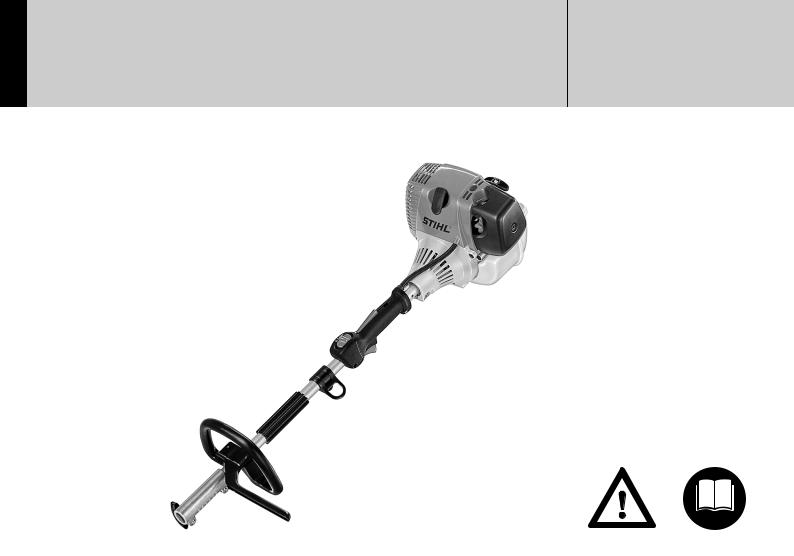
{
STIHL KM 110 R, 130 R
Instruction Manual
Manual de instrucciones
Warning!
Read and follow all safety precautions in Instruction Manual – improper use can cause serious or fatal injury.
Advertencia!
Lea y siga todas las precauciones de seguridad dadas en el manual de instrucciones – el uso incorrecto puede causar lesiones graves o mortales.
Instruction Manual
1 - 36
Manual de instrucciones 37 - 76
Contents
|
|
KombiSystem |
2 |
Trademarks |
|
|
Guide to Using this Manual |
2 |
|
Manual |
|
Safety Precautions and Working |
|
|
|
Techniques |
3 |
|
|
|
|
|
||
Instruction |
|
Approved KombiTools |
11 |
|
|
Adjusting the Throttle Cable |
13 |
|
|
|
|
Mounting the Loop Handle |
12 |
|
Original |
|
4-MIX Engine |
13 |
|
|
|
|
||
|
|
Fuel |
13 |
|
|
recycled. |
Fueling |
14 |
|
|
Starting / Stopping the Engine |
16 |
|
|
|
Operating Instructions |
18 |
|
|
|
be |
Cleaning the Air Filter |
18 |
|
|
can |
|
||
|
Engine Management |
19 |
|
|
|
paper |
|
||
|
Adjusting the Carburetor |
19 |
|
|
|
oils, |
|
||
|
Spark Arresting Screen in Muffler |
21 |
|
|
paperfree-chlorineon |
vegetablecontaininks |
|
||
Spark Plug |
22 |
|
||
|
|
|
||
|
|
Replacing the Starter Rope and |
|
|
|
|
Rewind Spring |
23 |
|
|
|
Storing the Machine |
25 |
|
Printed |
Printing |
Maintenance and Care |
26 |
|
Main Parts |
28 |
|
||
|
|
|
||
|
|
Specifications |
29 |
|
|
|
Special Accessories |
30 |
|
|
|
Maintenance and Repairs |
31 |
|
2012 |
|
STIHL Incorporated Federal |
|
|
|
Emission Control Warranty |
|
|
|
KG, |
|
|
|
|
|
Statement |
31 |
|
|
ANDREAS©STIHL AG & Co. |
|
|
||
8621-464-0458-E. VA1.C12. 0000000455005 GB |
STIHL Incorporated California |
|
|
|
{ |
|
|
||
|
|
Exhaust and Evaporative |
|
|
|
|
Emissions Control Warranty |
|
|
|
|
Statement |
33 |
|
English
35Allow only persons who fully understand the manuals of the KombiEngine and the KombiTool to operate this power tool combination.
To receive maximum performance and satisfaction from your STIHL power tool, it is important that you read, understand and follow the safety precautions and the operating and maintenance instructions in chapter "Safety
Precautions and Working Techniques" before using your power tool. For further information you can go to www.stihlusa.com.
Contact your STIHL dealer or the STIHL distributor for your area if you do not understand any of the instructions in the two manuals.
 Warning!
Warning!
Because this KombiEngine is the engine for a high-speed power tool, some special safety precautions must be observed to reduce the risk of per- sonal injury. Careless or improper use may cause serious or even fatal injury.
KM 110 R, KM 130 R |
1 |
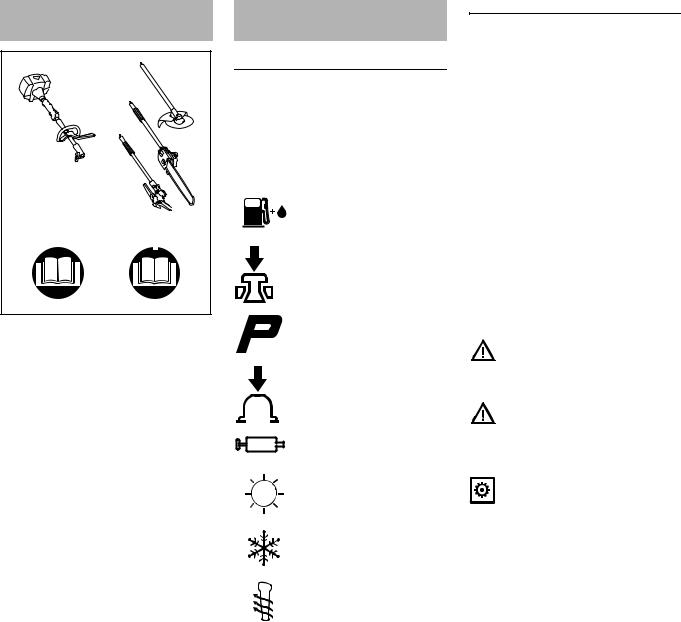
English
KombiSystem
+
....

+ |
KN |
|
002BA442 |
In the STIHL KombiSystem a number of different KombiEngines and KombiTools can be combined to produce a power tool. In this instruction manual the functional unit formed by the
KombiEngine and KombiTools is referred to as the power tool.
Therefore, the separate instruction manuals for the KombiEngine and KombiTool should be used together for the power tool.
Always read and and make sure you understand both instruction manuals before using your power tool for the first time and keep them in a safe place for future reference.
Guide to Using this Manual
Pictograms
The meanings of the pictograms attached to or embossed on the machine are explained in this manual.
Depending on the model concerned, the following pictograms may be on your machine.
Fuel tank for gasoline and engine oil mixture
Press to operate decom- pression valve
Manual fuel pump
Press to operate manual fuel pump
Filler hole for gear lubricant
Air intake summer mode
Air intake winter mode
Handle heating
Symbols in Text
Many operating and safety instructions are supported by illustrations.
The individual steps or procedures described in the manual may be marked in different ways:
N A bullet marks a step or procedure.
A description of a step or procedure that refers directly to an illustration may contain item numbers that appear in the illustration. Example:
N Loosen the screw (1).
N Lever (2) ...
In addition to the operating instructions, this manual may contain paragraphs that require your special attention. Such paragraphs are marked with the symbols and signal words described below:
DANGER
Indicates an imminent risk of severe or fatal injury.
WARNING
Indicates a hazardous situation which, if not avoided, could result in severe or fatal injury.
Indicates a risk of property damage, including damage to the machine or its individual components.
2 |
KM 110 R, KM 130 R |
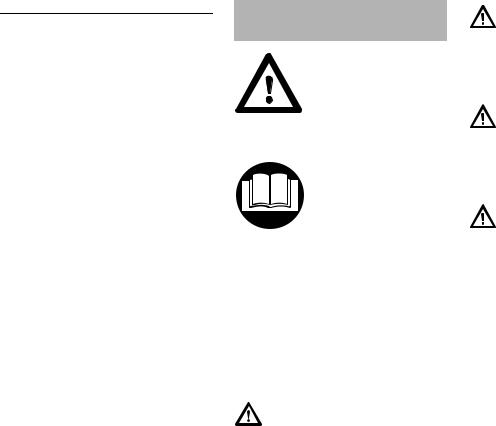
Engineering Improvements
STIHL’s philosophy is to continually improve all of its products. As a result, engineering changes and improvements are made from time to time. Therefore, some changes, modifications and improvements may not be covered in this manual. If the operating characteristics or the appearance of your machine differs from those described in this manual, please contact your STIHL dealer for assistance.
Safety Precautions and
Working Techniques
Because this KombiEn- gine is the engine for a high-speed power tool, special safety precau- tions must be observed to reduce the risk of per- sonal injury.
It is important that you read, fully understand and observe the following safety precautions and warnings. Read the instruction manuals and the safety precautions of your KombiEngine and KombiTool periodically.
Careless or improper use may cause serious or fatal injury.
Have your STIHL dealer show you how to operate your power tool. Observe all applicable local safety regulations, standards and ordinances.
Warning!
Do not lend or rent your power tool with- out the instruction manuals. Be sure that anyone using it understands the infor- mation contained in these manuals.
Use your power tool only for the applications described in the instruction manual of the KombiTool you are using.
English
Warning!
Do not use it for other purposes, since misuse may result in personal injury or property damage, including damage to the machine.
Warning!
Minors should never be allowed to use this power tool. Bystanders, especially children, and animals should not be allowed in the area where it is in use.
Warning!
To reduce the risk of injury to bystand- ers and damage to property, never let your power tool run unattended. When it is not in use (e.g. during a work break), shut it off and make sure that unauthor- ized persons do not use it.
Most of these safety precautions and warnings apply to the use of all STIHL power tools. Different models may have different parts and controls. See the appropriate section of your
KombiEngine and KombiTool instruction manuals for a description of the controls and the function of the parts of your model.
Do not clean your machine with a pressure washer. The solid jet of water may damage parts of the machine.
Safe use of a KombiEngine involves
1.the operator
2.the power tool
3.the use of the power tool
KM 110 R, KM 130 R |
3 |
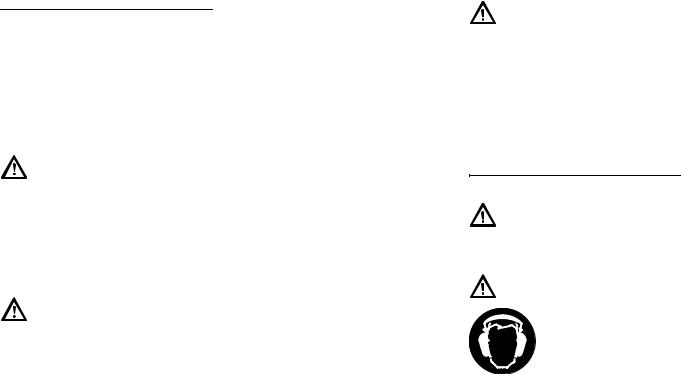
English
THE OPERATOR
Physical Condition
You must be in good physical condition and mental health and not under the influence of any substance (drugs, alcohol, etc.) which might impair vision, dexterity or judgment. Do not operate this machine when you are fatigued.
Warning!
Be alert – if you get tired, take a break. Tiredness may result in loss of control. Working with any power tool can be strenuous. If you have any condition that might be aggravated by strenuous work, check with your doctor before operating this machine.
Warning!
Prolonged use of a power tool (or other machines) exposing the operator to vibrations may produce whitefinger dis- ease (Raynaud's phenomenon) or carpal tunnel syndrome.
These conditions reduce the hand's ability to feel and regulate temperature, produce numbness and burning sensations and may cause nerve and circulation damage and tissue necrosis.
All factors which contribute to whitefinger disease are not known, but cold weather, smoking and diseases or physical conditions that affect blood vessels and blood transport, as well as high vibration levels and long periods of
exposure to vibration are mentioned as factors in the development of whitefinger disease. In order to reduce the risk of whitefinger disease and carpal tunnel syndrome, please note the following:
–Most STIHL power tools are available with an anti-vibration ("AV") system designed to reduce the transmission of vibrations created by the machine to the operator's hands. An AV system is recommended for those persons using power tools on a regular or sustained basis.
–Wear gloves – not while using KombiTool BG-KM – and keep your hands warm.
–Keep the AV system well maintained. A power tool with loose components or with damaged or worn AV elements will tend to have higher vibration levels.
–Maintain a firm grip at all times, but do not squeeze the handles with constant, excessive pressure. Take frequent breaks.
All the above-mentioned precautions do not guarantee that you will not sustain whitefinger disease or carpal tunnel syndrome. Therefore, continual and regular users should closely monitor the condition of their hands and fingers. If any of the above symptoms appear, seek medical advice immediately.
Warning!
The ignition system of the STIHL unit produces an electromagnetic field of a very low intensity. This field may inter- fere with some pacemakers. To reduce the risk of serious or fatal injury, persons with a pacemaker should consult their physician and the pacemaker manufac- turer before operating this tool.
Proper Clothing
Warning!
To reduce the risk of injury, the operator should wear proper protective apparel.
Warning!
Power tool noise may damage your hearing.
Wear sound barriers (ear plugs or ear mufflers) to
protect your hearing. Continual and regular
users should have their hearing checked regularly.
Be particularly alert and cautious when wearing hearing protection because your ability to hear warnings (shouts, alarms, etc.) is restricted.
4 |
KM 110 R, KM 130 R |
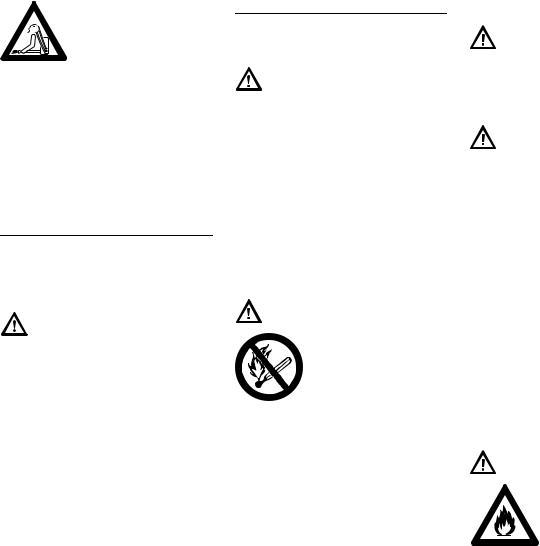
Avoid loose-fitting jack- ets, scarfs, neckties, jewelry, flared or cuffed pants, unconfined long hair or anything that could become caught on branches, brush or the moving parts of the unit. Secure hair so it is above shoulder level.
For further instructions on proper clothing see the safety precautions in the instruction manual of the KombiTool you are using.
THE POWER TOOL
For illustrations and definitions of the power tool parts see the chapter on "Main Parts."
Warning!
Never modify this power tool in any way. Only attachments supplied by STIHL or expressly approved by STIHL for use with the specific STIHL KombiEngine model are authorized. Although certain unauthorized attachments are useable with STIHL power tools, their use may, in fact, be extremely dangerous.
If this tool is subjected to unusually high loads for which it was not designed (e.g. heavy impact or a fall), always check that it is in good condition before continuing work. Check in particular that the fuel system is tight (no leaks) and that the controls and safety devices are working properly. Do not continue operating this machine if it is damaged. In case of doubt, have it checked by your STIHL servicing dealer.
KM 110 R, KM 130 R
THE USE OF THE POWER TOOL
Transporting the Power Tool
Warning!
Always switch off the engine and make sure the working tool has stopped before putting a power tool down. When transporting your power tool in a vehi- cle, properly secure it to prevent turnover, fuel spillage and damage to the power tool.
Fuel
Your STIHL power tool uses an oilgasoline mixture for fuel (see the chapter on "Fuel" of your instruction manual).
Warning!
Gasoline is an extremely flammable fuel. If spilled
and ignited by a spark or other ignition source, it can cause fire and seri- ous burn injury or
property damage. Use extreme caution when handling gasoline or fuel mix. Do not smoke or bring any fire or flame near the fuel or the power tool. Note that combustible fuel vapor may escape from the fuel system.
English
Fueling Instructions
Warning!
To reduce the risk of serious injury from burns, never attempt to refuel the unit until it has been completely removed from the operator.
Warning!
Fuel your power tool in well-ventilated areas, outdoors. Always shut off the engine and allow it to cool before refu- eling. Gasoline vapor pressure may build up inside the fuel tank depending on the fuel used, the weather conditions and the tank venting system.
In order to reduce the risk of burns and other personal injury from escaping gas vapor and fumes, remove the fuel filler cap on your power tool carefully so as to allow any pressure build-up in the tank to release slowly. Never remove the fuel filler cap while the engine is running.
Select bare ground for fueling and move at least 10 feet (3 m) from the fueling spot before starting the engine. Wipe off any spilled fuel before starting your machine.
Warning!
Check for fuel leakage while refueling and dur-
ing operation. If fuel leakage is found, do not start or run the engine until the leak is fixed and
any spilled fuel has been wiped away.
Take care not to get fuel on your cloth- ing. If this happens, change your clothing immediately.
5
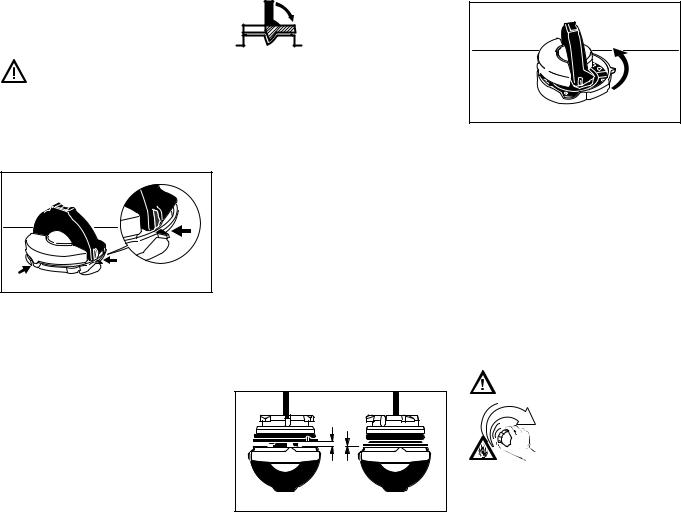
English
Different models may be equipped with different fuel caps.
Toolless cap with grip
Warning!
In order to reduce the risk of fuel spill- age and fire from an improperly tightened fuel cap, correctly position and tighten the fuel cap in the fuel tank opening.
001BA220 KN
To do this with this STIHL cap, raise the grip on the top of the cap until it is upright at a 90° angle. Insert the cap in the fuel tank opening with the raised positioning marks on the grip of the cap and on the fuel tank opening lining up. Using the grip, press the cap down firmly while turning it clockwise as far as it will go (approx. 1/4 turn).
Fold the grip flush with the top of the cap. Grip the cap and check for tightness. If the grip does not lie completely flush with the cap and the detent on the grip does not fit in the correspond- ing recess in the filler opening, or if the cap is loose in the filler opening, the cap is not properly seated and tightened and you must repeat the above steps.
Misaligned, damaged or broken cap
NIf the cap does not drop fully into the opening when the positioning marks line up and/or if the cap does not tighten properly when twisted, the base of the cap may be prematurely rotated (in relation to the top) to the closed position. Such misalignment can result from handling, cleaning or an improper attempt at tightening.
001BA227 KN |
Left: |
Base of cap in closed posi- |
|
tion (with open space) |
Right: |
Base of cap correctly posi- |
|
tioned for installation |
001BA226 KN |
NTo return the cap to the open position for installation, turn the cap (with the grip up) until it drops fully into the tank opening. Next, twist the cap counterclockwise as far as it will go (approx. 1/4 turn) – this will twist the base of the cap into the correct position. Then, twist the cap clockwise, closing it normally.
NIf your cap still does not tighten properly, it may be damaged or broken; immediately stop use of the unit and take it to your authorized STIHL dealer for repair.
Screw Cap
Warning!
Unit vibrations can cause an improperly tightened
fuel filler cap to loosen or
come off and spill quanti- ties of fuel. In order to reduce the risk of fuel
spillage and fire, tighten the fuel filler cap by hand as securely as possible.
See also the "Fueling" chapter in your
Instruction Manual for additional information.
6 |
KM 110 R, KM 130 R |
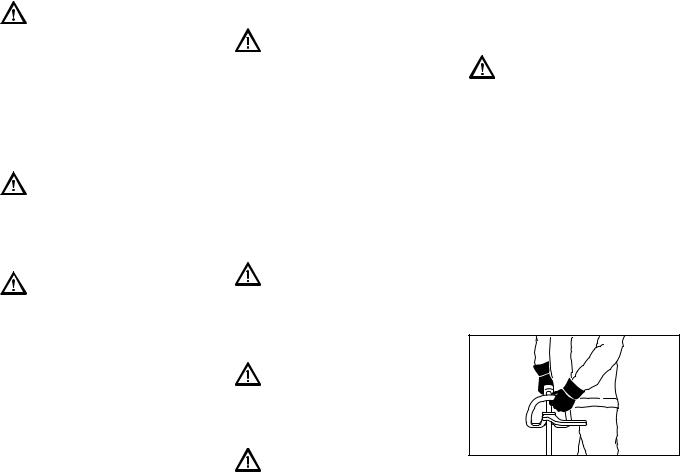
Before Starting
Warning!
Always check your power tool for proper condition and operation before starting, particularly the throttle trigger, throttle trigger lockout, stop switch, cutting attachment, deflector and harness. The throttle trigger must move freely and always spring back to the idle position.
Never attempt to modify the controls or safety devices.
Warning!
Never operate your power tool if it is damaged, improperly adjusted or main- tained, or not completely or securely assembled.
Warning!
Check that the spark plug boot is securely mounted on the spark plug – a loose boot may cause arcing that could ignite combustible fumes and cause a fire.
Keep the handles clean and dry at all times; it is particularly important to keep them free of moisture, pitch, oil, fuel mix, grease or resin in order for you to maintain a firm grip and properly control your power tool.
Starting
Start the engine at least 10 feet (3 m) from the fueling spot, outdoors only.
For specific starting instructions, see the appropriate section of your KombiEngine and KombiTool manuals.
Place the power tool on firm ground or
other solid surface in an open area.
Maintain good balance and secure footing.
Warning!
To reduce the risk of injury from loss of control, be absolutely sure that the working tool is clear of you and all other obstructions and objects, including the ground, because when the engine starts at starting-throttle, engine speed will be fast enough for the clutch to engage and move the working tool.
Once the engine has started, immediately blip the throttle trigger, which should release the starting throttle and allow the engine to slow down to idle.
Warning!
Your power tool is a one-person machine. Do not allow other persons in the general work area, even when starting.
Warning!
To reduce the risk of injury from loss of control, do not attempt to "drop start" your power tool.
Warning!
When you pull the starter grip, do not wrap the starter rope around your hand. Do not let the grip snap back, but guide the starter rope to rewind it properly.
Failure to follow this procedure may result in injury to your hand or fingers and may damage the starter mechanism.
English
See also the safety precautions on Starting in the instruction manual of the
KombiTool.
Important Adjustments
Warning!
To reduce the risk of personal injury from loss of control or contact with the running working tool, do not use a power tool with incorrect idle adjust- ment. At correct idle speed, the working tool should not move. For directions on how to adjust idle speed, see the appro- priate section of your instruction manual.
If you cannot set the correct idle speed, have your STIHL dealer check your power tool and make proper adjustments and repairs.
During Operation
Holding and Controlling the Power Tool
002BA057 KN
Always hold the unit firmly with both hands on the handles while you are working. Wrap your fingers and thumbs around the handles.
Your right hand should grip the rear handle. This also applies to left-handers.
KM 110 R, KM 130 R |
7 |

English
Warning!
To reduce the risk of injury from loss of control, never work on a ladder or on any other insecure support.
Working Conditions
Operate and start your power tool only outdoors in a well ventilated area. Operate it under good visibility and daylight conditions only. Work carefully.
Warning!
As soon as the engine is running, this product gen-
erates toxic exhaust
fumes containing chemi- cals, such as unburned hydrocarbons (including
benzene) and carbon monoxide, that are known to cause respiratory prob- lems, cancer, birth defects, or other reproductive harm. Some of the gases
(e.g. carbon monoxide) may be color- less and odorless. To reduce the risk of serious or fatal injury/illness from inhal- ing toxic fumes, never run the machine indoors or in poorly ventilated locations.
Warning!
Inhalation of certain dusts, especially organic dusts such as mold or pollen, can cause susceptible persons to have an allergic or asthmatic reaction. Sub- stantial or repeated inhalation of dust and other airborne contaminants, in par- ticular those with a smaller particle size, may cause respiratory or other ill- nesses. Control dust at the source where possible. Use good work prac- tices, such as operating the unit so that the wind or operating process directs any dust raised by the power tool away from the operator. Follow the recom- mendations of EPA/OSHA/NIOSH and occupational and trade associations with respect to dust ("particulate mat- ter"). When the inhalation of dust cannot be substantially controlled, i.e., kept at or near the ambient (background) level, the operator and any bystanders should wear a respirator approved by
NIOSH/MSHA for the type of dust encountered.
Operating Instructions
Warning!
Do not operate your power tool using the starting throttle lock, as you do not have control of the engine speed.
In the event of an emergency, switch off the engine immediately – move the slide control / stop switch to 0 or STOP.
Warning!
Never modify your muffler. Any modifi- cation could cause an increase in heat radiation, sparks or sound level, thereby increasing the risk of fire, burn injury or hearing loss. You may also permanently damage the engine. Have your muffler serviced and repaired by your STIHL servicing dealer only.
Warning!
The muffler and other parts of the engine (e.g. fins of the cylinder, spark plug) become hot during operation and remain hot for a while after stopping the engine. To reduce risk of burns, do not touch the muffler and other parts while they are hot. Keep the area around the muffler clean. Remove excess lubricant and all debris such as pine needles, branches or leaves. Let the engine cool down sitting on concrete, metal, bare ground or solid wood away from any combustible substances.
Warning!
An improperly mounted or damaged cyl- inder housing or a damaged/deformed muffler shell may interfere with the cool- ing process of the muffler. To reduce the risk of fire or burn injury, do not continue work with a damaged or improperly mounted cylinder housing or a dam- aged/deformed muffler shell.
Your muffler is furnished with a spark arresting screen designed to reduce the risk of fire from the emission of hot particles. Never operate your unit with a missing or damaged spark arresting screen. If your gas/oil mix ratio is correct
8 |
KM 110 R, KM 130 R |
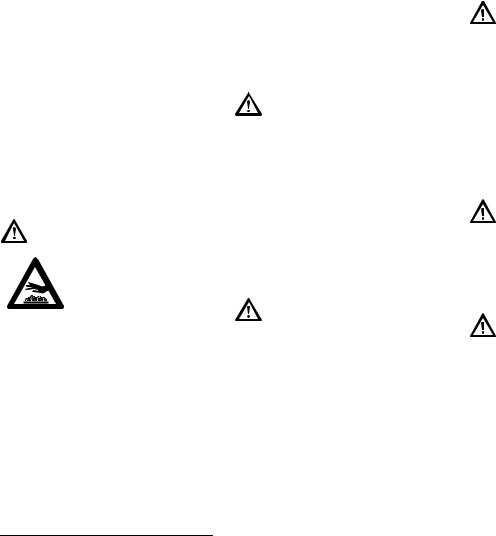
(i.e., not too rich), this screen will normally stay clean as a result of the heat from the muffler and need no service or maintenance. If you experience loss of performance and you suspect a clogged screen, have your muffler maintained by a STIHL servicing dealer. Some state or federal laws or regulations may require a properly maintained spark arrestor for certain uses. See the "Maintenance, Repair and
Storing" section of these Safety Precautions. Remember that the risk of a brush or forest fire is greater in hot or dry conditions.
Warning!
Some STIHL power tools are equipped with a cata-
lytic converter, which is
designed to reduce the exhaust emissions of the engine by a chemical
process in the muffler. Due to this proc- ess, the muffler does not cool down as rapidly as conventional mufflers when the engine returns to idle or is shut off.
To reduce the risk of fire and burn inju- ries when using a catalytic converter, always set your power tool down in the upright position and never locate it where the muffler is near dry brush, grass, wood chips or other combustible materials while it is still hot.
MAINTENANCE, REPAIR AND STORING
Maintenance, replacement, or repair of the emission control devices and systems may be performed by any nonroad engine repair establishment or
KM 110 R, KM 130 R
individual. However, if you make a warranty claim for a component which has not been serviced or maintained properly or if nonapproved replacement parts were used, STIHL may deny coverage.
Warning!
Use only identical STIHL replacement parts for maintenance and repair. Use of non-STIHL parts may cause serious or fatal injury.
Strictly follow the maintenance and repair instructions in the appropriate section of your KombiEngine and KombiTool instruction manuals. Please refer to the maintenance charts respectively the maintenance notes in these manuals.
Warning!
Always stop the engine and make sure that the working tool is stopped before doing any maintenance or repair work or cleaning the power tool. Do not attempt any maintenance or repair work not described in your KombiEngine and
KombiTool instruction manuals. Have such work performed by your STIHL servicing dealer only.
English
Warning!
Use the specified spark plug and make sure it and the ignition lead are always clean and in good condition. Always press spark plug boot snugly onto spark plug terminal of the proper size. (Note: If terminal has detachable SAE adapter nut, it must be attached.) A loose con- nection between spark plug boot and the ignition wire connector in the boot may create arcing that could ignite com- bustible fumes and cause a fire.
Warning!
Never test the ignition system with the ignition wire boot removed from the spark plug or with a removed spark plug, since uncontained sparking may cause a fire.
Warning!
Do not operate your power tool if the muffler is damaged, missing or modi- fied. An improperly maintained muffler will increase the risk of fire and hearing loss. Your muffler is equipped with a spark-arresting screen to reduce the risk of fire; never operate your power tool if the screen is missing, damaged or clogged. Remember that the risk of a brush or forest fire is greater in hot or dry weather.
In California, it is a violation of § 4442 or
§ 4443 or the Public Resources Code to use or operate gasoline-powered tools on forest-covered, brush-covered or grass-covered land unless the engine’s exhaust system is equipped with a complying spark arrester that is maintained in effective working order.
9
English
The owner/operator of this product is responsible for properly maintaining the spark arrester. Other states or governmental entities/agencies, such as the U.S. Forest Service, may have similar requirements. Contact your local fire agency or forest service for the laws or regulations relating to fire protection requirements.
Store the power tool in a dry and high or locked location out of reach of children.
Before storing for longer than a few days, always empty the fuel tank. See chapter "Storing the machine" in this manual.
10 |
KM 110 R, KM 130 R |
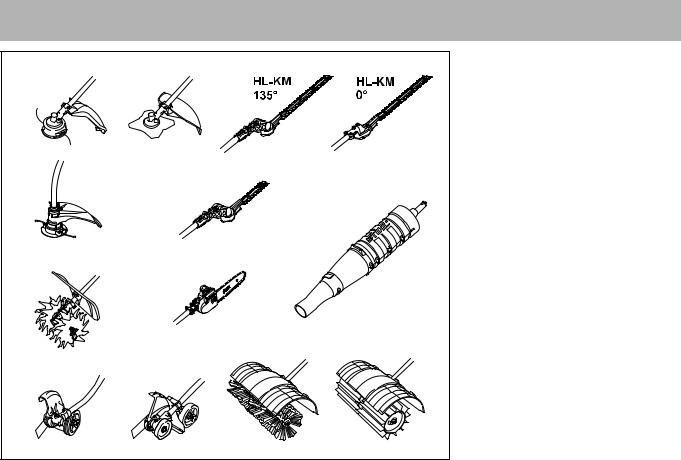
English
Approved KombiTools
FS-KM |
FS-KM |
|
FSB-KM |
FH-KM |
BG-KM |
BF-KM |
HT-KM |
|
|
|
|
|
KB-KM |
KW-KM |
FCB-KM |
FCS-KM |
|
|
|
470BA018 KN |
The following STIHL KombiTools may be mounted on the KombiEngine:
KombiTool |
Purpose |
FS-KM |
Brushcutter with |
|
mowing head |
FS-KM |
Brushcutter with |
|
grass cutting blade |
FSB-KM |
Brushcutter with |
|
mowing head |
HL-KM 135° |
Hedge trimmer, |
|
adjustable |
HL-KM 0° |
Hedge trimmer |
FH-KM 135° |
Power scythe |
BG-KM |
Blower |
HT-KM |
Pole pruner |
BF-KM |
Pick tines |
FCB-KM |
Power edger |
FCS-KM |
Power edger |
KB-KM |
Bristle brush |
KW-KM |
PowerSweep |
The barrier bar supplied with the machine must be mounted to the loop handle – see also "Mounting the Loop Handle".
KM 110 R, KM 130 R |
11 |
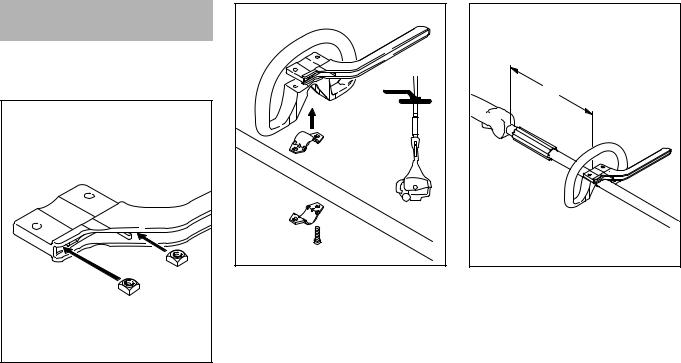
English
Mounting the Loop Handle
A barrier bar is supplied with the machine. Attach the barrier bar to the loop handle.
2 |
1 |
1 |
002BA098 KN |
NInsert square nuts (1) in the barrier bar (2) – the holes must line up
2
4
|
3 |
|
|
5 |
|
6 |
7 |
KN |
|
002BA099 |
|
|
|
NInsert the clamp (3) in the loop handle (4) and position them together on the shaft (5)
N Position clamp (6)
NPosition barrier bar (2) – note position!
N Line up the holes
NInsert bolts (7) in the holes – and screw them into the barrier bar as far as possible
A |
8 |
4 |
9 |
002BA353 KN |
NFit the loop handle (4) at a distance of (A) approx. 20 cm (8 in) forward of the control handle (8)
N Orient the loop handle
NTighten the bolts – lock the nuts if necessary
The sleeve (9) is present depending on the country and must be located between the loop handle and control handle.
Always leave the barrier bar attached.
12 |
KM 110 R, KM 130 R |
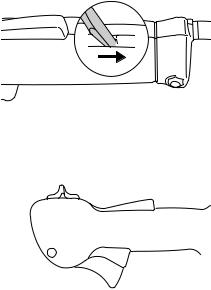
|
|
|
|
|
|
|
|
|
|
|
|
|
|
|
|
|
English |
|
|
|
|
|
|
|
|
|
|
|
|
|
|
|
|
|
|
Adjusting the Throttle Cable |
|
|
|
4-MIX Engine |
|
Fuel |
|||||||||||
|
|
|
|
|
|
|
|
|
|
|
|
|
|
|
|
|
|
A properly adjusted throttle cable is the |
|
The STIHL 4-MIX engine features |
|
This engine is certified to operate on |
|||||||||||||
precondition for correct operation in the |
|
mixture lubrication and must be run on a |
|
unleaded gasoline and the STIHL two- |
|||||||||||||
full throttle, starting throttle and idle |
|
|
|
fuel mixture of gasoline and engine oil. |
|
stroke engine oil at a mix ratio of 50:1. |
|||||||||||
positions. |
|
|
|
It operates otherwise on the 4-stroke |
|
Your engine requires a mixture of high- |
|||||||||||
|
|
|
|
|
|
|
|
|
|
|
|
|
|
|
|
||
N Adjust the throttle cable only when |
|
principle. |
|
quality gasoline and two-stroke air |
|||||||||||||
the unit is completely and properly |
|
|
|
cooled engine oil. |
|||||||||||||
assembled. |
|
|
|
|
|
Use mid-grade unleaded gasoline with a |
|||||||||||
|
|
|
|
|
|
|
|
|
|
|
|
|
|
|
|
|
|
|
|
|
|
|
|
|
|
|
|
|
|
|
|
|
|
|
minimum octane rating of 89 (R+M/2) |
|
|
|
|
|
|
|
|
|
|
|
|
|
|
|
|
||
|
|
|
|
|
|
|
|
|
|
|
|
|
|
|
|
|
and no more than 10% ethanol content. |
|
|
|
|
|
|
|
|
|
|
|
|
|
|
|
|
|
Fuel with a lower octane rating may |
|
|
|
|
|
|
|
|
|
|
|
|
|
|
|
|
|
|
|
|
|
|
|
|
|
|
|
|
|
|
|
|
|
|
|
|
|
|
|
|
|
|
|
|
|
|
|
|
|
|
|
|
||
|
|
|
|
|
|
|
|
|
|
|
|
|
|
|
|
|
increase engine temperatures. This, in |
|
|
|
|
|
|
|
|
|
|
|
|
|
|
|
|
||
|
|
|
|
|
|
|
|
|
|
|
|
KN |
|
|
|
turn, increases the risk of piston seizure |
|
|
|
|
|
|
|
|
|
|
|
|
|
|
|
||||
|
|
|
|
|
|
|
|
|
|
|
|
|
|
|
and damage to the engine. |
||
|
|
|
|
|
|
|
|
|
|
|
|
|
|
||||
|
|
|
|
|
|
|
|
|
|
|
|
002BA163 |
|
|
|
The chemical composition of the fuel is |
|
|
|
|
|
|
|
|
|
|
|
|
|
|
|
|
|
|
|
|
|
|
|
|
|
|
|
|
|
|
|
|
|
|
|
|
also important. Some fuel additives not |
N Use a suitable tool to push the slide |
|
|
|
only detrimentally affect elastomers |
|||||||||||||
|
|
|
(carburetor diaphragms, oil seals, fuel |
||||||||||||||
to the end of the slot (see |
|
|
|
|
|
||||||||||||
|
|
|
|
|
lines, etc.), but magnesium castings and |
||||||||||||
illustration). |
|
|
|
|
|
||||||||||||
|
|
|
|
|
catalytic converters as well. This could |
||||||||||||
|
|
|
|
|
|
|
|
|
|
|
|
|
|
|
|
|
|
|
|
|
|
|
|
|
|
|
|
|
|
|
|
|
|
|
cause running problems or even |
1 |
|
|
|
|
|
|
|
||||||||||
|
|
|
|
|
|
|
|
damage the engine. For this reason |
|||||||||
|
|
|
|
|
|
|
|
|
|
|
|
|
|
|
|
|
STIHL recommends that you use only |
|
|
|
|
|
|
|
|
|
|
|
|
|
|
|
|
|
high-quality unleaded gasoline! |
|
|
|
|
|
|
|
|
|
|
|
|
|
|
|
|
||
|
|
|
|
|
|
|
|
|
|
|
|
KN |
|
|
|
Gasoline with an ethanol content of |
|
|
|
|
|
|
|
|
|
|
|
|
|
|
|
||||
|
|
|
|
|
|
|
|
|
|
|
|
|
|
|
more than 10% can cause running |
||
2 |
|
|
|
|
|
|
|
|
002BA161 |
|
|
|
problems and major damage in engines |
||||
|
|
|
|
|
|
|
|
|
|
|
|
|
|||||
|
|
|
|
|
|
|
|
|
|
|
|
|
with a manually adjustable carburetor |
||||
|
|
|
|
|
|
|
|
|
|
|
|
|
|
|
|
|
and should not be used in such engines. |
|
|
|
|
|
|
|
|
|
|
|
|
|
|
|
|
||
NPress down the throttle trigger lockout (1) and squeeze the throttle trigger (2) (full throttle) – this sets the throttle cable correctly.
The ethanol content in gasoline affects engine running speed – it may be necessary to readjust the carburetor if you use fuels with various ethanol contents.
KM 110 R, KM 130 R |
13 |

English
Warning!
To reduce the risk of personal injury from loss of control and / or contact with the running cutting tool, do not use your unit with incorrect idle adjustment. At correct idle speed, the cutting tool should not move.
If your power tool shows an incorrect idle adjustment, have your STIHL dealer check your power tool and make proper adjustments and repairs.
The idle speed and maximum speed of the engine change if you switch from a fuel with a certain ethanol content to another fuel with a much higher or lower ethanol content.
This problem can be avoided by always using fuel with the same ethanol content.
Use STIHL HP Ultra oil or ask your dealer for an equivalent high quality oil to ensure the maximum performance of the product for the full lifetime.
To meet the requirements of EPA 40CFR90/1054 we recommend to use
STIHL HP Ultra oil.
Do not use BIA or TCW rated (twostroke water cooled) mix oils or other mix oils that state they are for use in both water cooled and air cooled engines (e.g., outboard motors, snowmobiles, chain saws, mopeds, etc.).
Take care when handling gasoline. Avoid direct contact with the skin and avoid inhaling fuel vapor. When filling at the pump, first remove the container from your vehicle and place the container on the ground before filling. To reduce the risk of sparks from static
discharge and resulting fire and/or explosion, do not fill fuel containers that are sitting in or on a vehicle or trailer.
The container should be kept tightly closed in order to limit the amount of moisture that gets into the mixture.
The machine’s fuel tank should be cleaned as necessary.
Fuel mix ages
Only mix sufficient fuel for a few days work, not to exceed 3 months of storage.
Store in approved fuel-containers only. When mixing, pour oil into the container first, and then add gasoline. Close the container and shake it vigorously by hand to ensure proper mixing of the oil with the fuel.
Gaso- |
Oil (STIHL 50:1 or equiva- |
line |
lent high-quality oils) |
US gal. US fl.oz.
12.6
2 1/2 |
6.4 |
512.8
Dispose of empty mixing-oil containers only at authorized disposal locations.
Fueling
Preparations




 002BA420 KN
002BA420 KN
NBefore fueling, clean the filler cap and the area around it to ensure that no dirt falls into the tank.
Always thoroughly shake the mixture in the canister before fueling your machine.
NPosition the machine so that the filler cap is facing up.
In order to reduce the risk of fire and personal injury from escaping gas vapor and fumes, remove the fuel filler cap carefully so as to allow any pressure build-up in the tank to release slowly.
One of two different filler caps is installed as standard at the factory.
14 |
KM 110 R, KM 130 R |
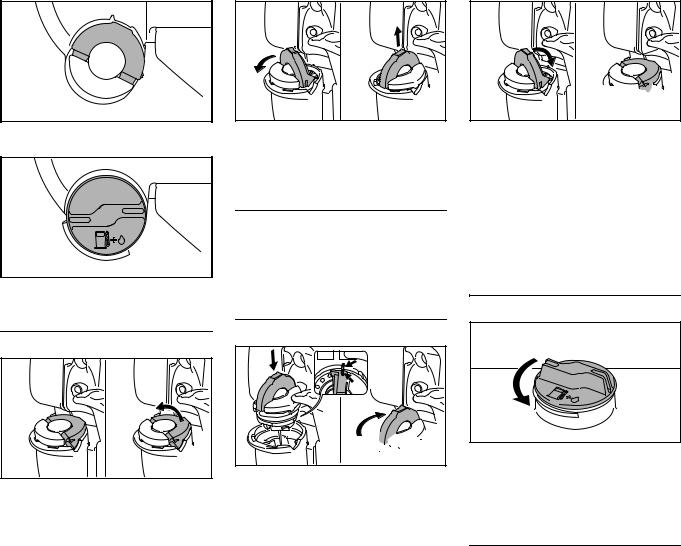
English
002BA418 KN
Toolless filler cap (with folding grip)
002BA419 KN
Threaded filler cap
Opening the toolless filler cap

 249BA054 KN
249BA054 KN
NTurn the cap counterclockwise (approx. 1/4 turn).
N Remove the filler cap.
Refueling
Take care not to spill fuel while fueling, and do not overfill the tank. STIHL recommends use of the STIHL filling system (special accessory).
Closing the toolless filler cap

 249BA053 KN
249BA053 KN
NSwing the grip into an upright position.






 249BA055 KN
249BA055 KN
NPosition the cap with the grip in an upright position; the raised positioning marks must line up.
NTurn cap clockwise as far as it will go (approx. 1/4 turn).
KM 110 R, KM 130 R







 249BA056 KN
249BA056 KN
NFold the grip down so that it is flush with the surface.
If the grip is not flush with the surface and the lug on the clip does not engage entirely in the recess (arrow), the cap is not properly closed and the steps described above must be repeated. See also the "Toolless cap with grip" section in the Safety Precautions.
Opening the threaded filler cap
002BA447 KN |
NTurn the cap counterclockwise until it can be removed from the tank opening.
N Remove the filler cap.
Refueling
Take care not to spill fuel while fueling and do not overfill the tank. STIHL recommends use of the STIHL filling system (special accessory).
15
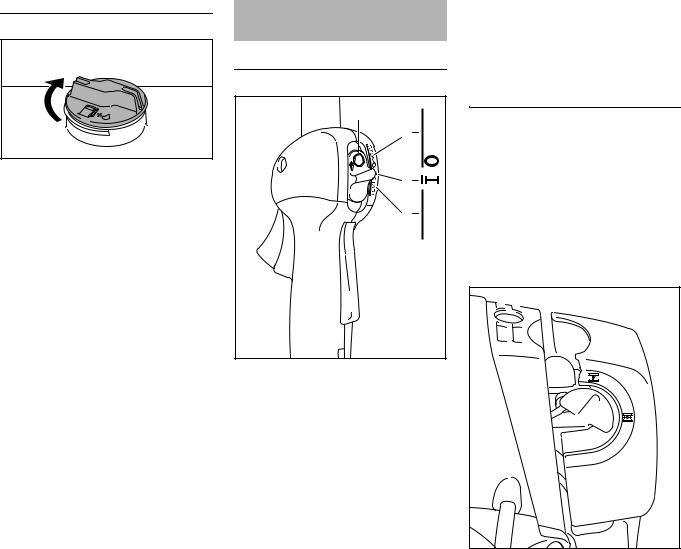
English
Closing the threaded filler cap
|
002BA448 KN |
N |
Position cap. |
NTurn the cap clockwise as far as it will go and tighten it as securely as possible by hand.
Starting / Stopping the
Engine
Controls
7 |
|
-STOP |
|
4 |
|
|
|
|
STOP |
|
|
3 |
5 |
START |
|
||
|
6 |
|
|
|
2
1
002BA181 KN
1 Throttle trigger lockout
2 Throttle trigger
3Slide control
Positions of slide control
4STOP-0 – engine off – the ignition is switched off
5F– normal run position – the engine is running or can start
6START – the ignition is switched on
– the engine can start
Symbol on slide control
7h– stop symbol and arrow. To stop the engine, push the slide control in
the direction of the arrow on the stop symbol (h) to STOP-0.
Starting
NPress down the trigger lockout lever and squeeze the throttle trigger.
N and hold them in that position.
NMove the slide control to START and hold it there.
NNow release the throttle trigger,
slide control and trigger lockout in that order. This is the starting throttle position.
9

 8
8
249BA057 KN
N Set the choke knob (8)
16 |
KM 110 R, KM 130 R |

g if the engine is cold
efor warm start – also use this posi- tion if the engine has been running but is still cold.
NPress the fuel pump bulb (9) at least five times – even if the bulb is filled with fuel.
Starting
















 552BA014 KN
552BA014 KN


























 552BA015 KN
552BA015 KN
NPlace the power tool on the ground so that it rests on the machine support: Check that the working tool is not touching the ground or any other obstacles – see also "Starting / Stopping the Engine" in the KombiTool instruction manual.
NMake sure you have a safe and secure footing.
NHold the unit with your left hand and press it down firmly – your thumb should be under the fan housing.
KM 110 R, KM 130 R
English
Your machine is now ready for operation.
Do not stand or kneel on the drive tube.
Stopping the engine

















 552BA016 KN
552BA016 KN
NHold the starter grip with your right hand.
NPull the starter grip slowly until you feel it engage and then give it a brisk strong pull.
Do not pull out the starter rope all the way – it might otherwise break.
NDo not let the starter grip snap back. Guide it slowly back into the housing so that the starter rope can rewind properly.
NCrank the engine until it begins to fire. After no more than five attempts, turn the choke knob to e.
N Continue cranking.
As soon as the engine runs
NBlip the throttle trigger. The slide
control moves to the normal run position F– and the engine settles down to idle speed.
Make sure the carburetor is correctly adjusted. The working tool must not rotate when the engine is idling.
NPush the slide control in the
direction of the arrow on the stop symbol (h) to STOP-0.
At very low outside temperatures:
As soon as the engine runs:
NBlip the throttle trigger to disengage the starting throttle position. The
slide control moves to the normal run position (F) – and the engine settles down to idle speed.
N Open the throttle slightly.
NWarm up the engine for a short period.
If the engine does not start
Choke knob
If you did not turn the choke knob to e quickly enough after the engine began to fire, the combustion chamber is flooded.
N Turn the choke knob to e.
NSet the slide control, lockout lever and throttle trigger to the starting throttle position.
NStart the engine by pulling the starter rope briskly – 10 to 20 pulls may be necessary.
17
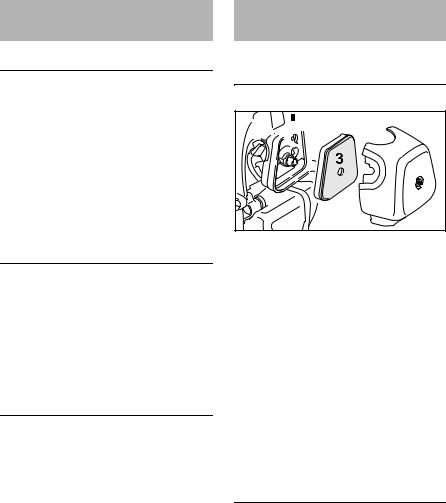
English
If the engine still does not start
N Move the slide control to STOP-0.
NRemove the spark plug – see "Spark Plug".
N Dry the spark plug.
NCrank the engine several times with the starter to clear the combustion chamber.
NRefit the spark plug – see "Spark
Plug".
N Move the slide control to START.
NSet the choke knob to e– even if the engine is cold.
N Now start the engine.
Throttle cable adjustment
NCheck adjustment of throttle cable – see chapter on "Adjusting the
Throttle Cable".
Fuel tank run until completely dry
NAfter refueling, press the fuel pump bulb at least five times – even if the bulb is filled with fuel.
NSet the choke knob according to engine temperature.
N Start the engine.
Operating Instructions
During break-in period
A factory-new machine should not be run at high revs (full throttle off load) for the first three tank fillings. This avoids unnecessary high loads during the break-in period. As all moving parts have to bed in during the break-in period, the frictional resistances in the engine are greater during this period. The engine develops its maximum power after about 5 to 15 tank fillings.
During Operation
After a long period of full throttle operation, allow the engine to run for a short while at idle speed so that engine heat can be dissipated by the flow of cooling air. This protects enginemounted components (ignition, carburetor) from thermal overload.
After Finishing Work
Storing for a short period: Wait for the engine to cool down. Empty the fuel tank and keep the machine in a dry place, well away from sources of ignition, until you need it again. For longer out-of- service periods – see "Storing the
Machine".
Cleaning the Air Filter
If there is a noticeable loss of engine power






 4
4
|
1 |
|
2 |
KN |
|
273BA006 |
||
|
N Turn the choke knob to g
NTake out the screw (1) and remove the filter cover (2).
NClean away loose dirt from around the filter.
NGrip the filter element (3) at the cutout (arrow) in the filter housing (4) and remove it.
NFit a new filter element. As a temporary measure you can knock it out on the palm of your hand or blow it out with compressed air. Do not wash.
N Replace damaged parts.
Installing the filter
NInstall the filter element in the filter housing and fit the cover.
NInsert the screw and tighten it down firmly.
18 |
KM 110 R, KM 130 R |
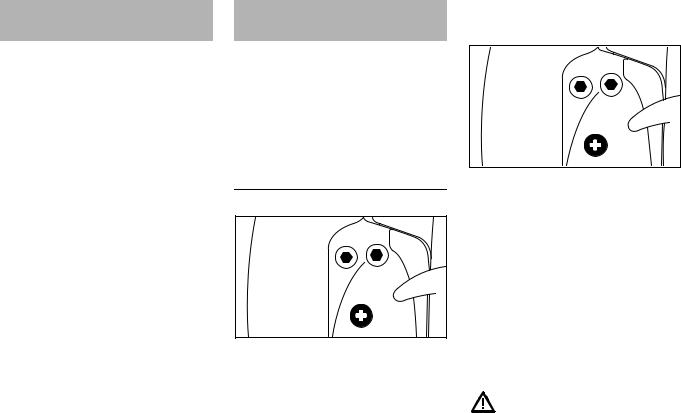
Engine Management
Exhaust emissions are controlled by the design of the fundamental engine parameters and components (e.g. carburation, ignition, timing and valve or port timing) without the addition of any major hardware.
English
Adjusting Idle Speed
Adjusting the Carburetor
Engine stops while idling
The carburetor comes from the factory with a standard setting.
This setting provides an optimum fuel-air mixture under most operating conditions.
These power tools are equipped with different carburetors:
Version A
H L |
|
|
KN |
LA |
249BA066 |
|
–High speed screw and low speed screw with special head – without slotted head.
On these machine versions it is no longer necessary to adjust the carburetor.
These machines have been set at the factory to provide an optimum fuel-air mixture in all locations and operating conditions.
H L |
|
|
KN |
LA |
249BA066 |
|
NWarm up the engine for about 3 minutes.
NTurn the idle speed screw (LA) slowly clockwise until the engine runs smoothly – the cutting attachment must not move.
Cutting attachment runs when engine is idling
NTurn the idle speed screw (LA) counterclockwise until the cutting attachment stops running and then turn the screw about another 1/2 to 3/4 turn in the same direction.
If the working tool or cutting attachment continues to run when the engine is idling, have your machine checked and repaired by your servicing dealer.
KM 110 R, KM 130 R |
19 |
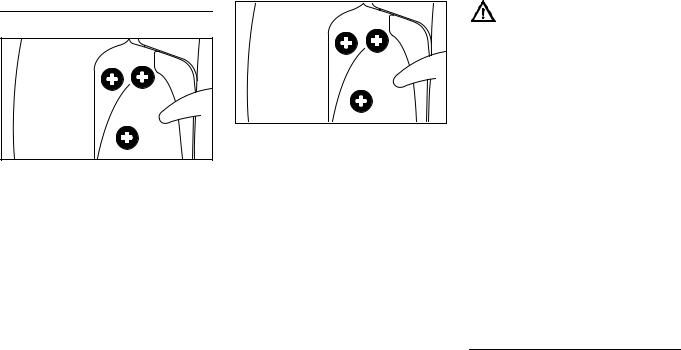
English
Version B
H L |
|
|
KN |
LA |
249BA067 |
|
–High speed screw and low speed screw with slotted head.
With this carburetor it is only possible to adjust the high speed and low speed screws within fine limits.
Standard Setting
N Stopping the Engine
NMount the KombiTool complete with working tool or cutting attachment.
NCheck the air filter and clean or replace as necessary.
NCheck that the throttle cable is properly adjusted – readjust if necessary – see chapter on "Adjusting the Throttle Cable".
NCheck the spark arresting screen
(not in all versions) and clean or replace as necessary.
20
H L |
|
|
KN |
LA |
249BA067 |
|
NCarefully turn both adjusting screws counterclockwise as far as stop:
–The high speed screw (H) is 3/4 turn open.
–The low speed screw (L) is 3/4 turn open.
N Start and warm up the engine.
NAdjust idle speed with the idle speed screw (LA) so that the cutting attachment does not move.
Adjusting Idle Speed
It is usually necessary to change the setting of the idle speed screw (LA) after every correction to the low speed screw
(L).
NWarm up the engine for about 3 minutes.
Engine stops while idling
NTurn the idle speed screw (LA) slowly clockwise until the engine runs smoothly – the cutting attachment must not move.
Cutting attachment runs when engine is idling
NTurn the idle speed screw (LA) counterclockwise until the cutting attachment stops running and then turn the screw about another 1/2 to 3/4 turn in the same direction.
If the working tool or cutting attachment continues to run when the engine is idling, have your machine checked and repaired by your servicing dealer.
Erratic idling behavior, engine stops even though setting of LA-screw has been corrected, poor acceleration
Idle setting is too lean:
NTurn the low speed screw (L) counterclockwise, no further than stop, until the engine runs and accelerates smoothly.
Erratic idling behavior
Idle setting is too rich
NTurn the low speed screw (L) clockwise, no further than stop, until the engine runs and accelerates smoothly.
Version B: Fine Tuning
A slight correction of the setting of the high speed screw (H) may be necessary if engine power is not satisfactory when operating at high altitude, sea level or after changing the working tool.
Rule of thumb:
Turn the high speed screw (H) about one quarter turn for every 1000m (3300 ft) change in altitude.
KM 110 R, KM 130 R
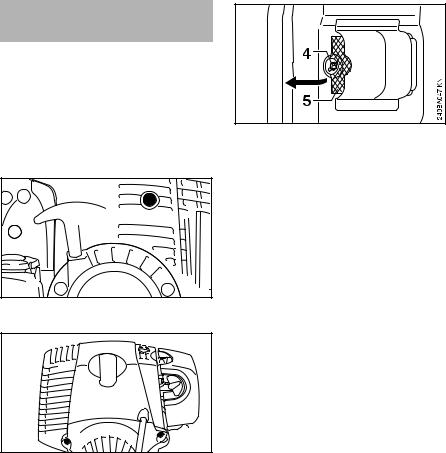
Conditions for adjustment
NCarry out the standard setting without disturbing the high speed screw (H).
NWarm up the engine for about 3 minutes.
N Open the throttle wide.
At high altitude
NTurn the high speed screw (H) clockwise (leaner), no further than stop, until there is no further noticeable increase in engine speed.
At sea level
NTurn the high speed screw (H) counterclockwise (richer), no further than stop, until there is no noticeable increase in engine speed.
It is possible that maximum engine speed may be reached with the standard setting.
Spark Arresting Screen in
Muffler
In some countries the muffler is equipped with a spark arresting screen.
NIf the engine is down on power, check the spark arresting screen in the muffler.
N Wait for the muffler to cool down.
N Move the slide control to STOP-0.

 1
1 




 249BA059 KN
249BA059 KN
N Take out the screw (1).
English
N Take out the screw (4).
NLift the spark arresting screen (5) and pull it out.
NClean the spark arresting screen. If the screen is damaged or heavily carbonized, fit a new one.
N Refit the spark arresting screen.
NInsert the screw and tighten it down firmly.
N Fit the shroud.
|
3 |
249BA060 KN |
2 |
2 |
NTake out the screws (2) and remove the shroud (3).
KM 110 R, KM 130 R |
21 |

English
Spark Plug
If engine is down on power, difficult to start or runs poorly at idling speed, first check the spark plug.
Fit a new spark plug after approx. 100 operating hours or earlier if the
electrodes are badly eroded.
Wrong fuel mix (too much engine oil in the gasoline), a dirty air filter and unfavorable running conditions (mostly at part throttle etc.) affect the condition of the spark plug. These factors cause deposits to form on the insulator nose which may result in trouble in operation.
Removing the spark plug
N Move the slide control to STOP-0.
 1
1 







 KN249BA063
KN249BA063
N Pull off the spark plug boot (1).
N Unscrew the spark plug.
Checking the Spark Plug
|
KN |
A |
000BA039 |
|
N Clean dirty spark plug.
NCheck electrode gap (A) and readjust if necessary – see "Specifications".
NUse only resistor type spark plugs of the approved range.
Rectify problems which have caused fouling of spark plug:
–Too much oil in fuel mix.
–Dirty air filter.
–Unfavorable running conditions, e.g. operating at part load.
1
 2
2
002BA363 KN
Warning!
To reduce the risk of fire and burn injury, use only spark plugs authorized by STIHL. Always press spark plug boot (1) snugly onto spark plug terminal (2) of the proper size. (Note: If terminal has detachable SAE adapter nut, it must be attached.) A loose connection between spark plug boot and ignition wire con- nector in the boot may create arcing that could ignite combustible fumes and cause a fire.
22 |
KM 110 R, KM 130 R |
